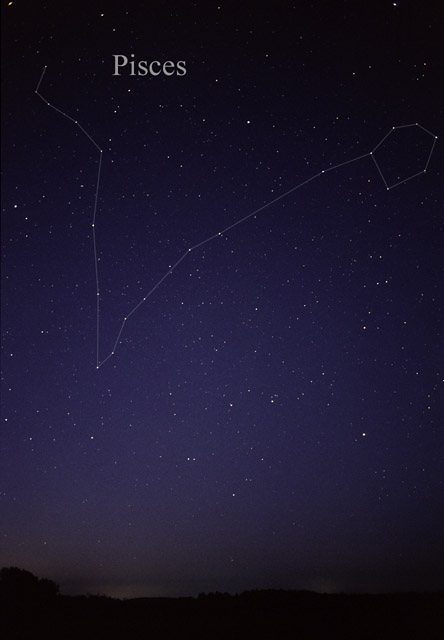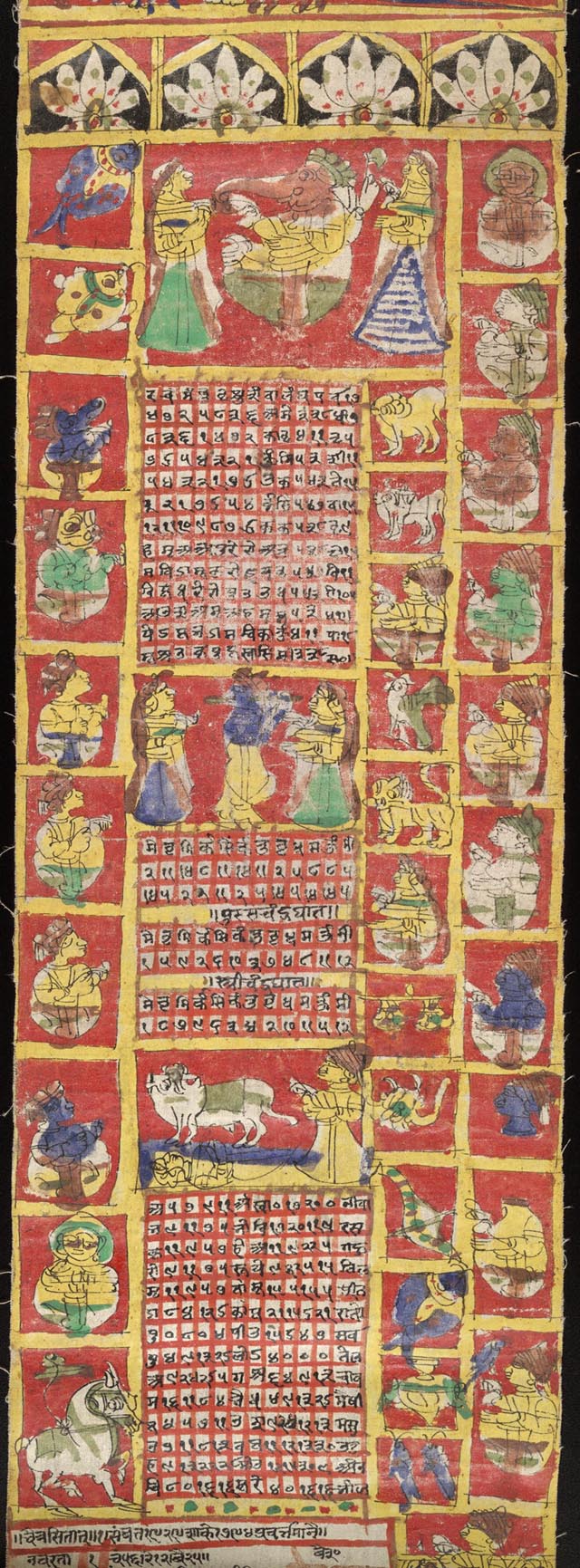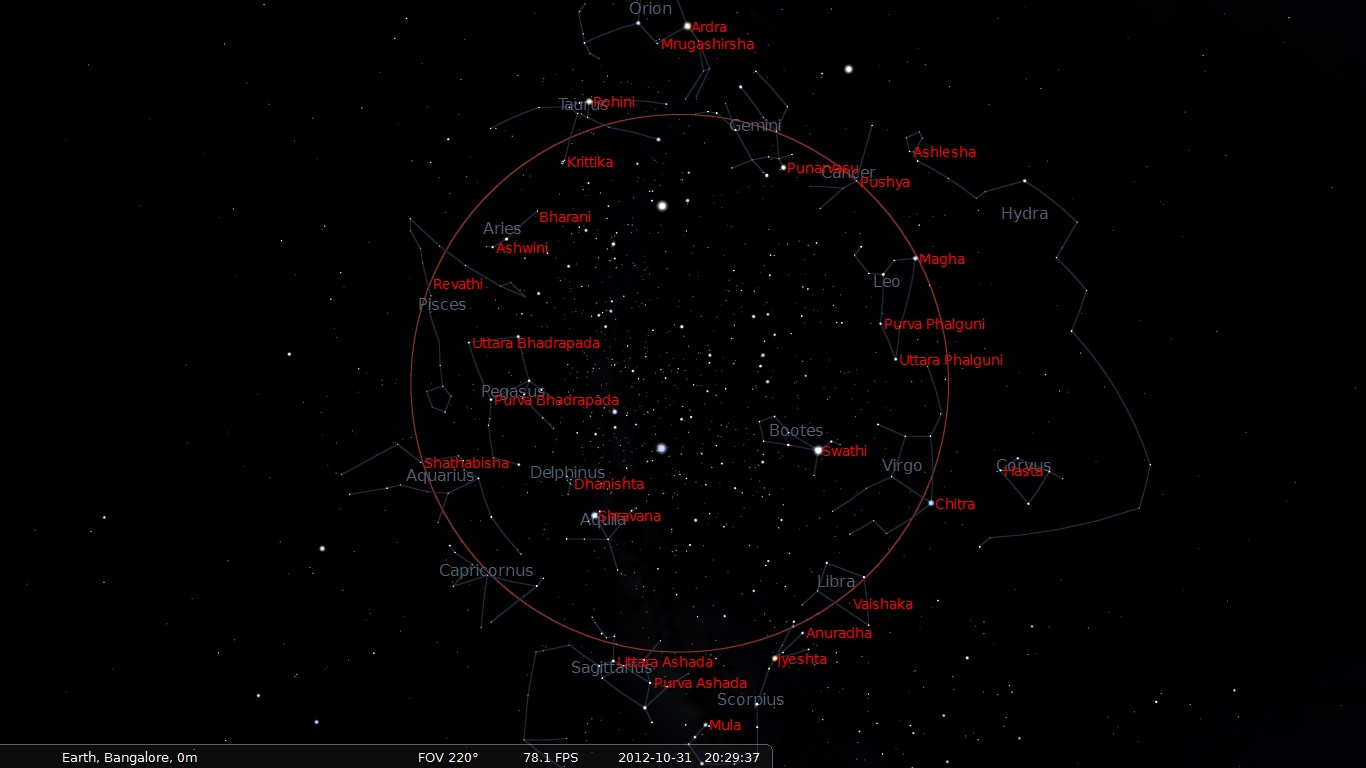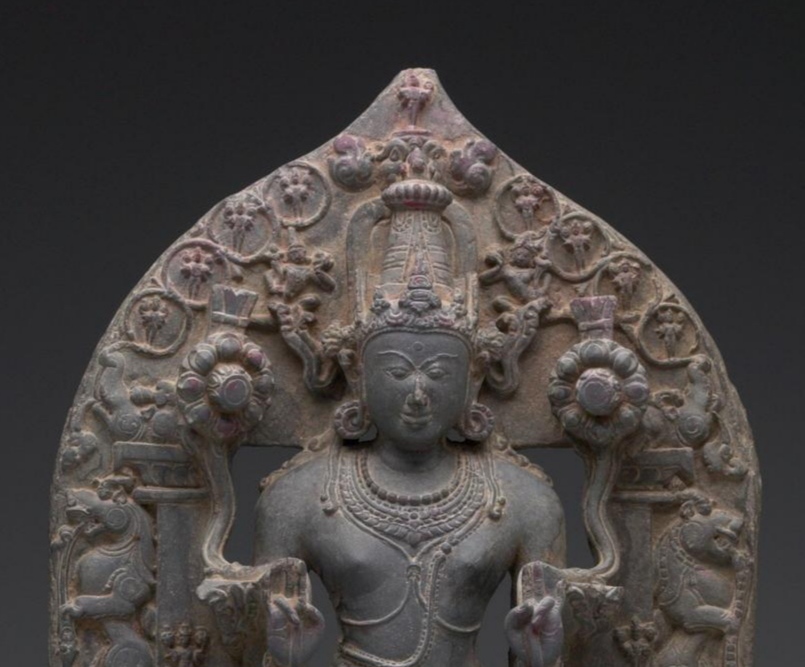|
Revati (nakshatra)
Revati is the Hindu name for Zeta Piscium, a star on the edge of the Pisces zodiac constellation. In Hindu sidereal astronomy this star is identified as the March Equinox (confusingly with historic reasons, most often referred to as the First Point of Aries), i.e. when the Sun crosses this star, a new solar year begins. Revathi is the last star in the Pisces constellation, which is the last zodiac sign. Ashwini is the first star in Aries constellation, which is the first zodiacal sign. Astrology Revati (Devanagari: रेवती) is the twenty-seventh nakshatra in Hindu astrology (or the 28th, if Abhijit is counted) corresponding to ζ Piscium. It is ruled by Puṣan, one of the 12 Ādityas. According to the beliefs of traditional electional astrology, Revati is a sweet or delicate nakshatra, meaning that while Revati has the most influence, it is best to begin working on things of physical beauty like music and jewellery . Revati is symbolized by fish (often a pai ... [...More Info...] [...Related Items...] OR: [Wikipedia] [Google] [Baidu] |
Pisces Constellation Map
Pisces may refer to: *Pisces (astrology), an astrological sign Astronomy *Pisces (constellation), a constellation ** Pisces Overdensity, an overdensity of stars in the Milky Way's halo that is situated in the Pisces constellation ** Pisces II, a satellite galaxy of the Milky Way ** Pisces Dwarf, a satellite galaxy of the Triangulum Galaxy ** Pisces (Chinese astronomy), the division of the sky in traditional Chinese uranography that lies across the modern constellation Pisces Science and technology * Pisces, an obsolete (because of land vertebrates) taxonomic superclass including all fish A fish (: fish or fishes) is an aquatic animal, aquatic, Anamniotes, anamniotic, gill-bearing vertebrate animal with swimming fish fin, fins and craniate, a hard skull, but lacking limb (anatomy), limbs with digit (anatomy), digits. Fish can ... * PISCES (Personal Identification Secure Comparison and Evaluation System), a border control database system administered by the United States Dep ... [...More Info...] [...Related Items...] OR: [Wikipedia] [Google] [Baidu] |
Zeta Piscium
Zeta Piscium (ζ Piscium, abbreviated Zet Psc, ζ Psc) is a quintuple star system in the zodiac constellation of Pisces. Based upon parallax measurements obtained during the Hipparcos mission, it is located roughly distant from the Sun. The system consists of a binary star (Zeta Piscium A) and a triple star system (BC), the latter consisting of a spectroscopic binary (B) and a single star (C). A's two components are themselves designated Zeta Piscium Aa (officially named Revati ) and Ab; B's two components as Ba and Bb. As the star system is 0.21° south of the ecliptic, it can be eclipsed (occulted) by the moon, when close to or at one of its two nodes of its orbit; and is eclipsed by the sun from about 8-10 April. Nomenclature ''ζ Piscium'' ( Latinised to ''Zeta Piscium'') is the system's Bayer designation. The designations of the three constituents as ''Zeta Piscium A'', ''B'' and ''C'', and those of ''A's'' and ''B's'' components - ''Zeta Piscium Aa'', ''Ab'' ... [...More Info...] [...Related Items...] OR: [Wikipedia] [Google] [Baidu] |
Pisces (constellation)
Pisces is a constellation of the zodiac. Its vast bulk – and main asterism viewed in most European cultures per Greco-Roman antiquity as a distant pair of fishes connected by one cord each that join at an apex – are in the Northern celestial hemisphere. Its old astronomical symbol is (♓︎). Its name is Latin for "fishes". It is between Aquarius, of similar size, to the southwest and Aries, which is smaller, to the east. The ecliptic and the celestial equator intersect within this constellation and in Virgo. The Sun passes directly overhead of the equator, on average, at approximately this point in the sky, at the March equinox. The right ascension/declination 00 is located within the boundaries of Pisces. Features The March equinox is currently located in Pisces, due south of Psc, and, due to precession, slowly drifting due west, just below the western fish towards Aquarius. Stars Although Pisces is a large constellation, there are only two stars bri ... [...More Info...] [...Related Items...] OR: [Wikipedia] [Google] [Baidu] |
Indian Astronomy
Astronomy has a long history in the Indian subcontinent, stretching from History of India, pre-historic to History of India (1947–present), modern times. Some of the earliest roots of Indian astronomy can be dated to the period of Indus Valley civilisation or earlier. Astronomy later developed as a discipline of Vedanga, or one of the "auxiliary disciplines" associated with the study of the Vedas dating 1500 BCE or older. The oldest known text is the ''Vedanga Jyotisha'', dated to 1400–1200 BCE (with the extant form possibly from 700 to 600 BCE). Indian astronomy was influenced by Greek astronomy beginning in the 4th century BCEHighlights of Astronomy, Volume 11B: As presented at the XXIIIrd General Assembly of the IAU, 1997. Johannes Andersen Springer, 31 January 1999 – Science – 616 pages. p. 72/ref>Babylon to Voyager and Beyond: A History of Planetary Astronomy. David Leverington. Cambridge University Press, 29 May 2010 – Science – 568 pages. p. 4/ref>Th ... [...More Info...] [...Related Items...] OR: [Wikipedia] [Google] [Baidu] |
Devanagari
Devanagari ( ; in script: , , ) is an Indic script used in the Indian subcontinent. It is a left-to-right abugida (a type of segmental Writing systems#Segmental systems: alphabets, writing system), based on the ancient ''Brāhmī script, Brāhmī'' script. It is one of the official scripts of India, official scripts of India and Nepal. It was developed in, and was in regular use by, the 8th century CE. It had achieved its modern form by 1000 CE. The Devanāgarī script, composed of 48 primary characters, including 14 vowels and 34 consonants, is the fourth most widely List of writing systems by adoption, adopted writing system in the world, being used for over 120 languages, the most popular of which is Hindi (). The orthography of this script reflects the pronunciation of the language. Unlike the Latin alphabet, the script has no concept of letter case, meaning the script is a unicase, unicameral alphabet. It is written from left to right, has a strong preference for symmetri ... [...More Info...] [...Related Items...] OR: [Wikipedia] [Google] [Baidu] |
Nakshatra
Nakshatra () is the term for Lunar mansion in Hindu astrology and Buddhist astrology. A nakshatra is one of 27 (sometimes also 28) sectors along the ecliptic. Their names are related to a prominent star or asterisms in or near the respective sectors. In essence (in Western astronomical terms), a nakshatra simply is a constellation. Every nakshatra is divided into four ''padas'' ( "steps"). The starting point for the nakshatras according to the ''Vedas'' is "Krittika" (it has been argued, because the Pleiades may have started the year at the time the ''Vedas'' were compiled, presumably at the vernal equinox), but, in more recent compilations, the start of the nakshatras list is the point on the ecliptic directly opposite the star Spica, called ''Chitrā'' in Sanskrit. This translates to Ashwinī, a part of the modern constellation of Aries. These compilations, therefore, may have been compiled during the centuries when the sun was passing through Aries at the time of the ver ... [...More Info...] [...Related Items...] OR: [Wikipedia] [Google] [Baidu] |
Abhijit (nakshatra)
Abhijit () is a unique nakshatra and the 28th nakshatra in the Indian system of 28 nakshatras, out of which 27 are traditional nakshatras and this one is an intercalary nakshatra. It is a division in the constellation Capricornus, spanning from the fourth pada of Uttara Ashadha to the first pada of Shravana. Abhijit is the Sanskrit name for Vega, the brightest star in the northern constellation of Lyra. The name Abhijit means "the victorious one" in Sanskrit. History In the Bhagavata Purana, Vishnu, in the incarnation of Krishna, tells Uddhava that among the nakshatras, he is Abhijit, highlighting the auspiciousness of this nakshatra.Srimad Bhagavatam, Canto 11, Chapter 16, Text/Verse 27 Abhijit's longitude spans from 06° 40' to 10° 53' 20" in the constellation of Capricornus, covering the last quarter of Uttara Ashadha to the first quarter of Shravana. As a result, the Abhijit nakshatra is not a regular nakshatra with four padas but rather a intercalary nakshatra. It is ... [...More Info...] [...Related Items...] OR: [Wikipedia] [Google] [Baidu] |
Pisces (constellation)
Pisces is a constellation of the zodiac. Its vast bulk – and main asterism viewed in most European cultures per Greco-Roman antiquity as a distant pair of fishes connected by one cord each that join at an apex – are in the Northern celestial hemisphere. Its old astronomical symbol is (♓︎). Its name is Latin for "fishes". It is between Aquarius (constellation), Aquarius, of similar size, to the southwest and Aries (constellation), Aries, which is smaller, to the east. The ecliptic and the celestial equator intersect within this constellation and in Virgo (constellation), Virgo. The Sun subsolar point, passes directly overhead of the equator, on average, at approximately this point in the sky, at the March equinox. The right ascension/declination 00 is located within the boundaries of Pisces. Features The March equinox is currently located in Pisces, due south of Psc, and, due to precession, slowly drifting due west, just below the western fish towards Aquari ... [...More Info...] [...Related Items...] OR: [Wikipedia] [Google] [Baidu] |
Pushan
Pushan (, ) is a Hindu Vedic solar deity and one of the Adityas. He is the god of meeting. Pushan is responsible for marriages, journeys, roads, and the feeding of cattle. He was a psychopomp (soul guide), conducting souls to the other world. He protected travelers from bandits and wild beasts, and protected men from being exploited by other men. He was a supportive guide, a "good" god, leading his adherents towards rich pastures and wealth. Etymology Traditionally, the name of the deity is said to be derived from Sanskrit verb, ''pūṣyati'', which means "to cause to thrive". Many modern scholars consider Pushan to be derived from the reconstructed Proto-Indo-European god ''* Péh₂usōn'', which would thereby make Pushan a cognate of the Greek god Pan. The connection between Pan and Pushan was first proposed by the German scholar Hermann Collitz in 1924. Texts Ten hymns in the Rigveda are dedicated to Pūṣan (including one jointly to Soma and Pūṣan and another t ... [...More Info...] [...Related Items...] OR: [Wikipedia] [Google] [Baidu] |
Ādityas
In Hinduism, Adityas ( ) refers to a group of major solar deities, who are the offspring of the goddess Aditi. The name ''Aditya'', in the singular, is taken to refer to the solar deity, sun god Surya. Generally, Adityas are twelve in number and consist of Vivasvan (Surya), Aryaman, Tvashtr, Savitr, Bhaga, Dhatr, Mitra (Hindu god), Mitra, Varuna, Amsha, Pushan, Indra and Vishnu (in the form of Vamana). They appear in the ''Rig Veda'', where they are 6–8 in number, all male. The number increases to 12 in the ''Brahmanas''. The Mahabharata and the ''Puranas'' mention the sage Kashyapa as their father. In each month of the year a different Aditya is said to shine. Sun worship Characterisation The Aditya have been described in the Rig Veda as bright and pure as streams of water, free from all guile and falsehood, blameless, perfect. This class of deities has been seen as upholding the movables and immovable Dharma. Adityas are beneficent gods who act as protectors of all ... [...More Info...] [...Related Items...] OR: [Wikipedia] [Google] [Baidu] |
Electional Astrology
Electional astrology, also known as ''event'' astrology, is a branch found in most traditions of astrology according to which a practitioner decides the most appropriate time for an event based on the astrological auspiciousness of that time. It differs from horary astrology because, while horary astrologers seek to find the answer to a question based on the time the question was asked, electional astrologers seek to find a period of time which will result in the most preferable outcome for an event being planned. Historically used primarily to schedule battles, electional astrology has been used by its proponents to plan a number of events, including weddings and trips. Modern discoveries about the true nature of celestial objects has undermined theoretical bases for believing that their motions affect luck, and empirical scientific investigation has shown that predictions and recommendations based on these systems are not accurate. Astrology in general counts as a pseudo ... [...More Info...] [...Related Items...] OR: [Wikipedia] [Google] [Baidu] |



